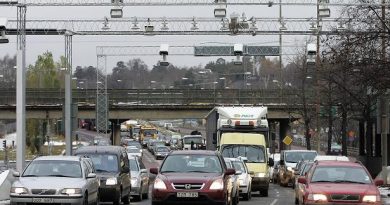Here comes Yakutia, Russia’s newest nuclear icebreaker

The flag-raising ceremony happened at the Baltic Shipyard in St. Petersburg on December 28. It took four and a half years to build the Yakutia and the icebreaker is the first made with mostly Russian-made components.
Testing took place in the Gulf of Finland earlier in December and the powerful vessel is now delivered to Rosatomflot, the state-owned company in charge of sailings and infrastructure along the Northern Sea Route.
The three previous icebreakers of the same class had both Western and Ukrainian made parts. With sanctions implemented and the engine factory in Ukraine bombed, the shipyard had to look for import substitutes domestically.
“The sanctions restrictions that we faced did not prevent us from ensuring high-quality and timely construction of the order,” said Deputy General Director Andrei Buzinov with the Baltic Shipyard at the ceremony.
The Yakutia is powered by two RITM-200 reactors and will join the fleet of nuclear-powered icebreakers sailing out of Rosatomflot’s base in Murmansk.
The three sister vessels of the same class, the Arktika, Sibir and Ural are already crushing the ice along the Northern Sea Route, mainly for Russia’s LNG export to reach the markets.
The fleet also includes four older nuclear-powered icebreakers, the Yamal and 50 Let Poedy, and the two Finnish built Taymyr and Vaygash. They have all got their service life prolonged.
Not since the late 1980s have more nuclear-powered icebreakers been in operation. Out at sea, the winter season 2024/2025 will be a record as several of the icebreakers in the late Soviet times stayed at port in Murmansk although they officially were on active duty.
Important for economy
Dictator Vladimir Putin sent his greetings to the participants in the flag-raising ceremony of Yakutia.
Putin pointed to the importance of the icebreakers in Russia’s Arctic ambitions.
“ … it will contribute to addressing key multifaceted challenges facing the national economy, and further solidify Russia’s status as a naval power,” Putin said.
The flag raising ceremony took place 65 years after the Soviet Union’s first nuclear-powered icebreaker, the Lenin, was launched from the yard in Severodvinsk. Lenin became the world’s first civilian nuclear-powered vessel and is today moored in Murmansk as a museum open to the public.
The two last icebreakers of the new class will also be named after past dictators. The Leningrad and Stalingrad are expected to be put in service in 2028 and 2030. Before that, the Chukotka will come in 2026.
If no unforeseen delays happen.
Last week, the Defense Ministry’s cargo ship Ursa Major sank in the Mediterranean with two 45-tons hatches to cover the reactors on the Rossiya icebreaker currently under construction at the yard in Bolshoi Kamen near Vladivostok.
The giant icebreaker is already many years behind schedule and is unlikely to be start sailing the Northern Sea Route’s East Arctic waters in 2027 as stipulated.
Related stories from around the North:
Canada: Canadian military says it has tracked, stopped China surveillance in Arctic waters, The Canadian Press
Finland: Icebreaker cooperation with U.S.-Canada among topics in Finland’s prez, Trump call, Yle News
Denmark: Nordics consider joint procurement of infantry fighting vehicle, The Independent Barents Observer
Iceland: Arctic allies meet in Iceland to tackle growing security challenges, climate, Eye on the Arctic
Norway: Norway defence budget to ensure armed forces strong enough to deter Russia, The Independent Barents Observer
Russia: Russia says it has no illusions about Trump, will robustly defend its interests, Thomson Reuters
Sweden:Government ‘prepared’ for a Trump win, Swedish FM, Radio Sweden
United States: Harry S. Truman carrier strike group on exercise inside the Arctic Circle, Alaska Public Media



